YE OLD TIMBER TAVERN ON COURT ST (1926)
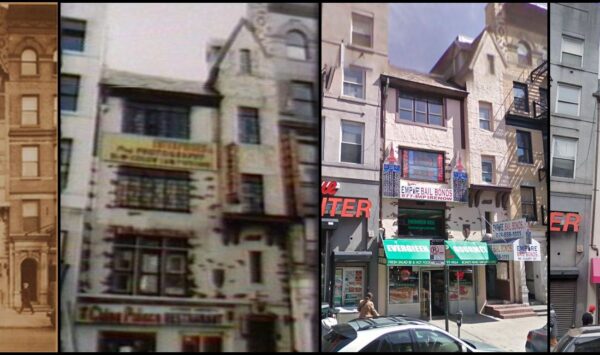
******************************************************************************************************************************** Brownstone Detectives investigates the history of our clients’ homes. The story you are about to read was composed from research conducted in the course of one of those investigations. Do you know the history of YOUR house? ******************************************************************************************************************************** Old English architecture is a rare sight in New York City. Rare, interestingly, because it once had a distinct place and time in the history of New York City’s 20th century architectural development. As tastes changed, however, its look – sometimes referred to as Tudor, Chester, Jacobean, Elizabethan, &c. – quickly fell into disfavor. Also, its reliance upon such materials as wood and stucco – those that can easily wear if not well maintained – forced owners of these structures to look for more long-term solutions to their maintenance. One of these solutions usually meant simply covering their more wearable materials with those that stood up better to weather. Although it would take nearly a century to do, such is the case with No. 93 Court Street, initially designed in the Old English style. “Brooklyn’s most distinctive office building,” started a Brooklyn Daily Eagle article in October of 1926, “may well be the description of the new home of Malkind & Weinstein, architects, which is being completed at 93 Court st., and is expected to be ready for occupancy in November.” The article went on to highlight the building’s design and beauty. “The building will carry out the style of Old English architecture in every detail in its exterior, while the […]
THE SPITE HOUSE OF MELROSE AVENUE (1899)
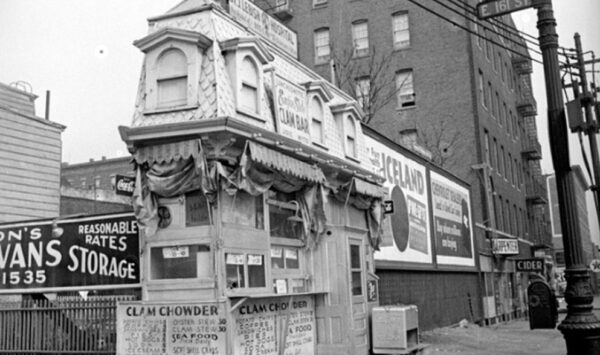
******************************************************************************************************************************** Brownstone Detectives investigates the history of our clients’ homes. The story you are about to read was composed from research conducted in the course of one of those investigations. Do you know the history of YOUR house? ******************************************************************************************************************************** Around the turn of the last century, Melrose Avenue in the Bronx was widened. The land that the city needed to perform this expansion was purchased from private owners. In some cases, however, it left some very-difficult-to-build-on lots. Such was the case with a lot on the corner of East 161st Street and Melrose Avenue. From The Strand Magazine, 1899. “This odd building stood on the corner of 161st Street and Melrose Avenue, New York City. It was a bit over 4ft. in depth, 17ft. frontage, and one and a-half storeys high, with a basement and sub-basement built under the broad sidewalk, extending to the curb. The house itself was of wood, on a steel frame, and had a slate roof. “Its owner was an eccentric tailor, who lived and carried on his trade below the street. The interior consisted of a small show-room, a store-room, and spiral iron stairway going down to the ‘lower regions.’ “The upper storey seems to have been constructed merely as a finishing touch. It was reached by an iron ladder from the store-room. The entire construction, appointments, and fittings were very ingenious, and were all the ideas of the owner. “The story of the house was that the original lot was cut away in opening […]
THE FARMS LINES OF BROOKLYN (1874)
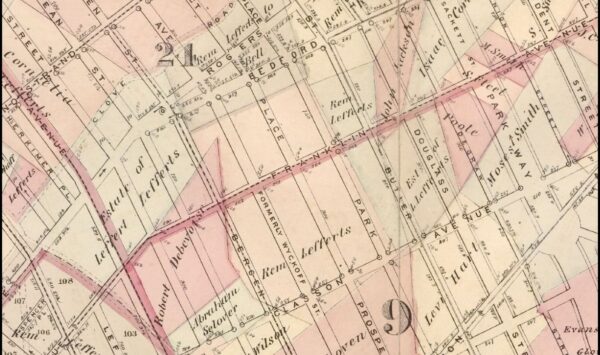
******************************************************************************************************************************** Brownstone Detectives investigates the history of our clients’ homes. The story you are about to read was composed from research conducted in the course of one of those investigations. Do you know the history of YOUR house? ******************************************************************************************************************************** Brooklyn was once one giant farm. At some point, as the farms began to be split up to be sold to developers – those who wanted to build rows of prized brownstones – companies also began to pop up which developed maps showing what types of buildings existed on every “lot” within the city. Although no longer used for fire insurance purposes, they are great tools for those owners wishing to research the histories of their properties. If you own a home in New York City, these maps can help you to determine how old it is, what else had been built in the area when your house was new, and, on some maps, the name of the farmer that had once owned your land. Find yours HERE. Follow @BrownstoneDetec Share ———————————————————————————————————————– The Brownstone Detectives Brownstone Detectives is an historic property research agency. Our mission is to document and save the histories of our clients’ homes. From our research, we produce our celebrated House History Books and House History Reports. Contact us today to begin discovering the history of your home.
FINDING $1.5M IN YOUR BROWNSTONE (1934)
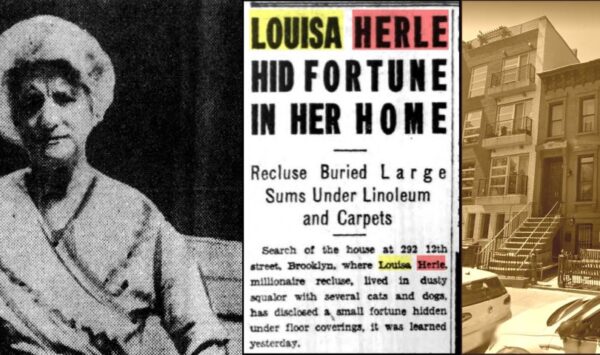
******************************************************************************************************************************** Brownstone Detectives investigates the history of our clients’ homes. The story you are about to read was composed from research conducted in the course of one of those investigations. Do you know the history of YOUR house? ******************************************************************************************************************************** Does a small fortune lie secreted away within the walls of your brownstone? If you live in a certain Park Slope brownstone, you may want to start looking… THE FORTUNE AT NO. 292 12th STREET (The following story comes from the Friday, 2 November 1934 edition of the Home Talk section of The Brooklyn Eagle newspaper.) She died as she had lived—alone. Miss Louisa Herle, 74-year-old wealthy recluse, of No. 292 12th St., was the Hetty Green of South Brooklyn, and although she slept on a dilapidated leatherette lounge in her kitchen, she left a fortune of $1,500,000. The dead body of the aged spinster was found lying on the lounge Wednesday, where it had lain for three days. She had removed her shoes before she lay down, and her stockings had been placed over the arm of a rocking chair. In the squalid two rooms on the street floor of the old brownstone house, Miss Herle had lived since 1916, when her brother had died. Following his death she closed the upper floors of the-house, and the rooms, inches deep in dust, and piled high with broken furniture, had never been opened since. Three heavily barred doors led into the living room where an old fashioned safe stood. Miss Herle, […]
THE MARXIST AT No. 477 E. 16th St. (1910)
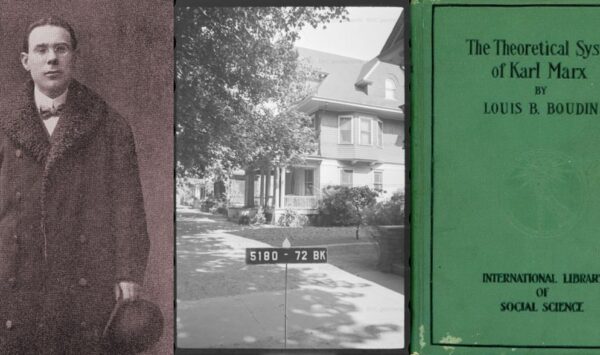
******************************************************************************************************************************** Brownstone Detectives investigates the history of our clients’ homes. The story you are about to read was composed from research conducted in the course of one of those investigations. Do you know the history of YOUR house? ******************************************************************************************************************************** At No. 477 East Sixteenth Street lived a Socialist. He wasn’t your ordinary, run-of-the-mill Socialist, however. Louis B. Boudin was a Russian-born American Marxist theoretician, writer, politician, and lawyer, who wrote a two volume history of the Supreme Court’s influence on American government as well as his piece de resistance, The Theoretical System of Karl Marx in the Light of Recent Criticism, first published in 1907. Boudin’s family emigrated to America in June 1891 and settled in New York City. He worked in the garment industry as a shirt maker and as a private tutor. At the same time, Boudin began legal studies, gaining a Master’s Degree from New York University and being admitted to the New York State Bar Association in 1898. At first, Boudin was a member of the Socialist Labor Party of America. He was also a member of the governing National Executive Board of the party’s trade union affiliate, the Socialist Trade and Labor Alliance from 1898 to 1899. Although he left the party for a short period, he returned after the turn of the century, being elected a delegate of the Socialist Party of America of the International Socialist Congress in Stuttgart in 1907 and the 1910 Copenhagen Congress of the Second International. Boudin was frequently […]
THE PLAN TO SEGREGATE BED-STUY (1937)
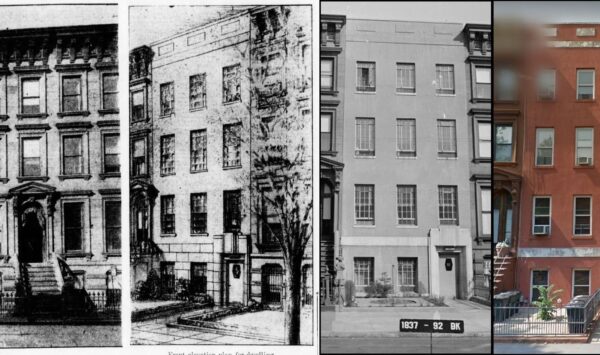
******************************************************************************************************************************** Brownstone Detectives investigates the history of our clients’ homes. The story you are about to read was composed from research conducted in the course of one of those investigations. Do you know the history of YOUR house? ******************************************************************************************************************************** In 1937, much of Brooklyn’s brownstone stock was reaching its limits. Its townhouses were, on average, approximately 50 years old and, in the eyes of many residents and brokers, outmoded of interior and unattractive of exterior. In fact, residents of certain sections of Brooklyn were beginning to move out of the older sections with the ancient brownstones, in favor of the newly constructed apartment buildings – or simply to other outlying sections of the borough. There were those residents, however, who felt that they saw a bigger problem, an over-arching trend that, unchecked, had the potential to destroy investment, send house values spiraling downward, and force them to move out of a community where they – and their families – had lived for generations. For these residents, the problem fell less into the category of an ageing housing stock than into that of the lot of outsiders – those of a different economic class, certainly those of a different race – who were already beginning to move into them. The problem of the outdated housing stock, while real, was not the sole impetus to modernize. Rather, that incentive came from a fear of an undesirable population that must, at all costs, be kept at bay. It was, thus, that a move […]
THE “TAXPAYER” COMETH (1930s)
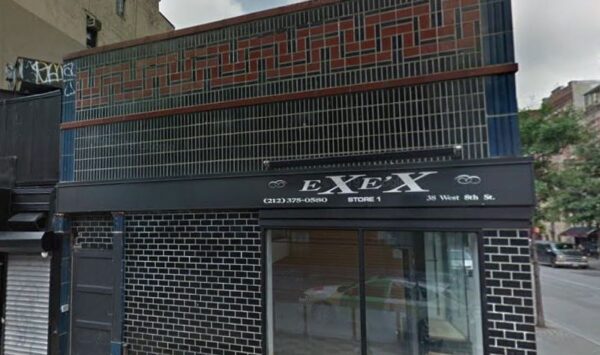
******************************************************************************************************************************** Brownstone Detectives investigates the history of our clients’ homes. The story you are about to read was composed from research conducted in the course of one of those investigations. Do you know the history of YOUR house? ******************************************************************************************************************************** We all know what a brownstone looks like. But, do you know what a “TAXPAYER” is? Most would consider the term a reference to a person who “gives to Caesar what is Caesar’s.” While that is true, we are referring to a type of building that was labelled with the term almost 100 years ago in the wake of the Depression. AN ECONOMICALLY-DRIVEN ARCHITECTURAL STYLE Shortly after the start of the Depression, as larger structures (apartments, flats, &c.) did not bring the return on investment during this period, New York City land owners often built temporary 1- or 2-story buildings on their lots to cover their property tax. They would rent the low-rise properties to business owners who would operate their businesses out of the structures, collect rent from the one resident, and pay the taxes. Always meant to be temporary until the end of the Depression, it was always the idea that property owners would demolish their taxpayers at the end of the bad economic times – to be replaced with multi-story structures that would bring in higher rent rolls. Not all of them were destroyed, however, and thousands can be seen throughout New York City today. Follow @BrownstoneDetec Share ———————————————————————————————————————– The Brownstone Detectives Brownstone Detectives is an historic property […]
SPEEDING DRIVER, OVERTURNED CAR (1931)
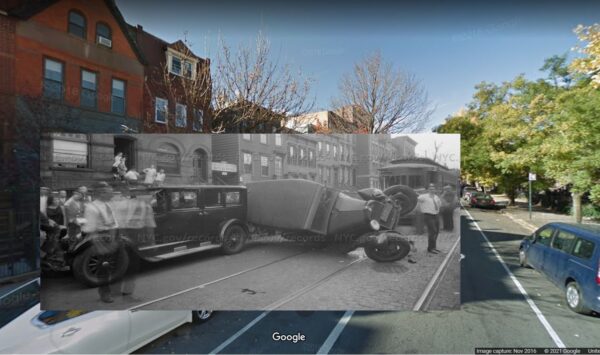
******************************************************************************************************************************** Brownstone Detectives investigates the history of our clients’ homes. The story you are about to read was composed from research conducted in the course of one of those investigations. Do you know the history of YOUR house? ******************************************************************************************************************************** The guilty one was evident. The accident was seen by at least 40 trolley riders, several automobile drivers, and a number of pedestrians, on Bergen Street near Bedford Avenue. It was around 8 p.m. on A Friday. A laundry truck had been motoring east on Bergen Street when its chauffeur, possibly eager for the weekend, attempted to pass a trolley car ahead of him that was going (too slow, likely for the chauffeur) in the same direction. As the laundry truck cleared this trolley car, however, its chauffeur became suddenly aware of a westbound trolley car bearing down on him in his direction. There was no time or space to change direction of the automobile and the two vehicles collided at a relatively high rate of speed. The force of the collision threw the truck into the path of the eastbound trolley that the chauffeur had just tried to pass, which also ended up striking the laundry truck, itself. It was unknown whether the laundry truck chauffeur was injured as he didn’t stick around long enough, fleeing the scene, according to the police, about as soon as his truck had found its final resting place. According to the Brooklyn Daily Eagle, nine passengers on the two Bergen Street trolley cars were […]
“ANYTHING FER THANKSGIVING?”
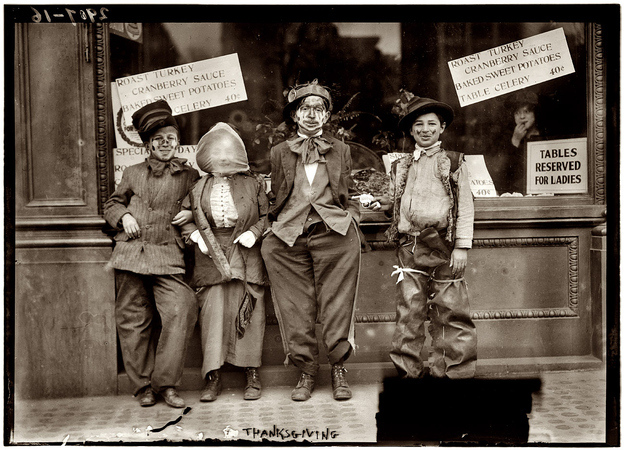
******************************************************************************************************************************** Brownstone Detectives investigates the history of our clients’ homes. The story you are about to read was composed from research conducted in the course of one of those investigations. Do you know the history of YOUR house? ******************************************************************************************************************************** Before there was Halloween “trick-or-treating” – there was another tradition in Brooklyn: Thanksgiving “begging.” A STORY ABOUT CHILDREN PANHANDLING IN BROOKLYN Most people have never heard of this custom, but that is because it ended sometime in the 1940s or 1950s here in the northeastern part of the U.S. But in the process of doing research on a brownstone for a Brownstone Detectives House History Book, we tracked down a former resident who, during her interview, and to our great surprise, began telling us about this defunct holiday. “In the morning we were dressed up as hobos, in whatever old clothes our parents gave us,” said Patricia O’Neill who used to live at 738 Macon Street in the eastern section of Bedford-Stuyvesant, “and we went from door to door saying, ‘Anything for Thanksgiving?’ “They used to give us a dime or an apple.” O’Neill (Loftus at the time) remembers the custom well. Where she grew up in Bedford-Stuyvesant, all of the kids dressed as hobos and they spent the morning of Thanksgiving Day carousing the neighborhood “begging” for food and money from their neighbors. THE HISTORY The custom which started around 1870 may have a connection to Martinmas, the feast day of St. Martin of Tours, patron saint of beggars and […]
HOW ART DECO CAME TO PARK SLOPE (1931)
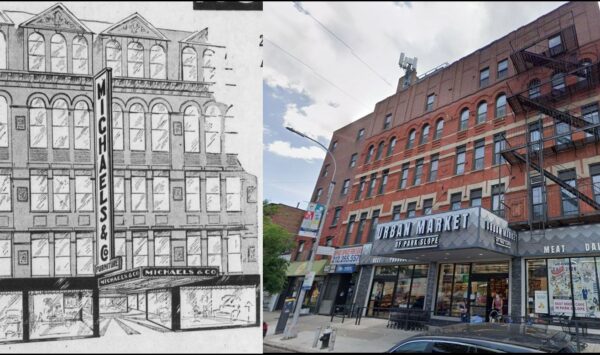
******************************************************************************************************************************* Brownstone Detectives investigates the history of our clients’ homes. The story you are about to read was composed from research conducted in the course of one of those investigations. Do you know the history of YOUR house? *******************************************************************************************************************************Up until the 1930s, everything in Park Slope was Victorian brownstone. But then came Michael’s and the revelation of a stunning Art Deco facelift. ART DECO IN THE HOUSE For those of you familiar with 5th Avenue in Brooklyn, you may be acquainted with the 5-story building with storefronts known as Nos. 503-505. Currently housing Urban Market of Park Slope, the entire floor was at one time taken over with bedroom sets, kitchen tables, and dinettes – a furniture store known as Michael’s & Co. Originally, the building – sitting between 12th and 13th streets – had quite a different look – a product of the Queen Anne/Romanesque architectural period in the late 1800s, its top floor was lined with faux gables and a mansard roof. By the 1930s, a vertical sign and a marquee had been added to the facade, both with the Michael’s name. Today, of course, Michael’s is no more and all of the Victorian architectural features toward the top of the building (as well as the Michael’s signs) have been removed – probably as much out of an extreme aversion to the cost of maintaining such a facade as due to some of extreme economic periods the building’s passed through. Nonetheless, its current facade is rather unremarkable, particularly […]